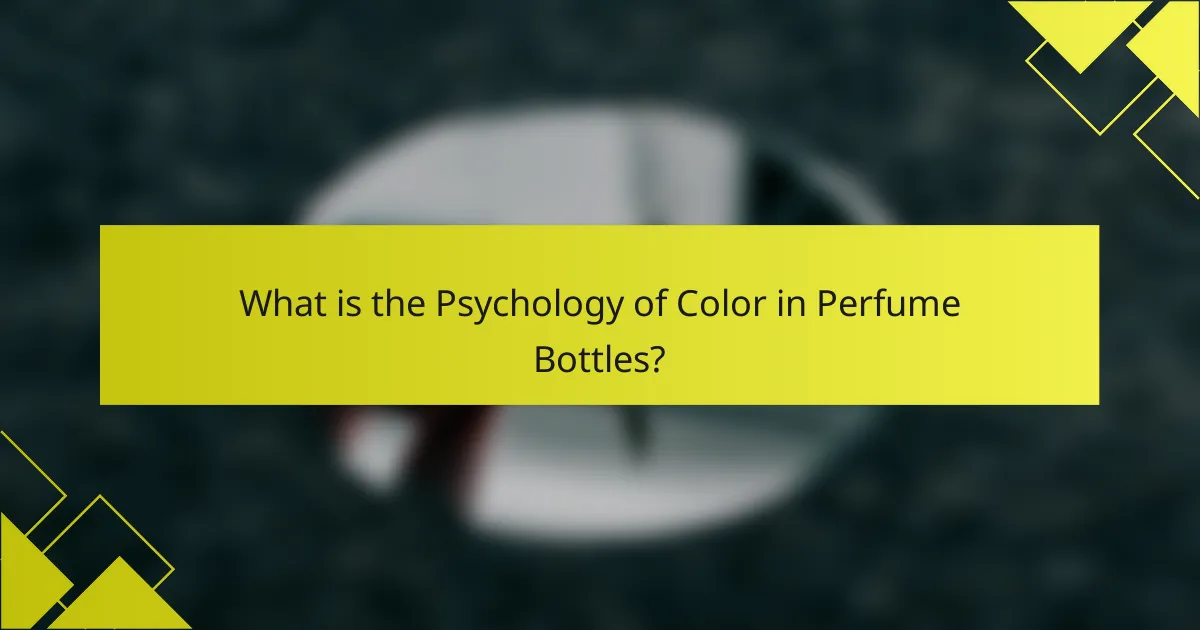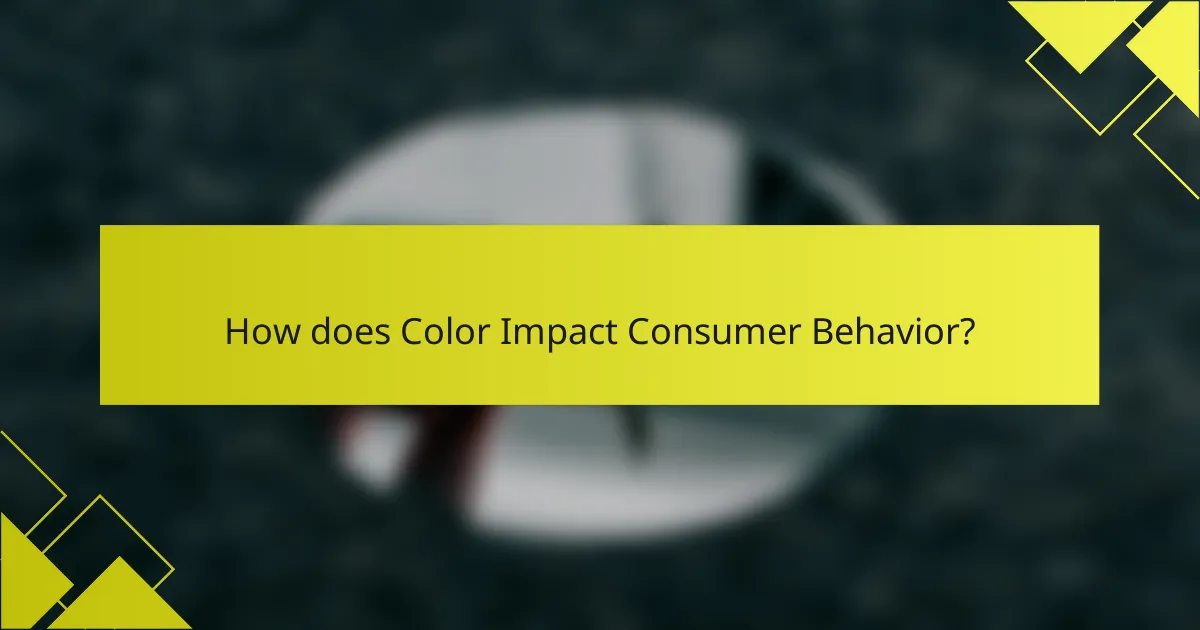
What is the Psychology of Color in Perfume Bottles?
The psychology of color in perfume bottles influences consumer perception and behavior. Colors evoke emotions and associations that can affect purchasing decisions. For instance, blue often conveys calmness and trust, while red signifies passion and excitement. Research shows that 85% of consumers make purchasing decisions based on color alone. This highlights the importance of color in branding and marketing. Brands strategically choose colors to align with their identity and target audience. The right color can enhance the perceived value of the fragrance. Thus, color psychology plays a crucial role in the design of perfume bottles.
How does color influence emotional responses in consumers?
Color significantly influences emotional responses in consumers. Different colors evoke specific feelings and associations. For example, red can stimulate excitement and passion. Blue often promotes calmness and trust. Yellow is linked to happiness and optimism. Studies show that 85% of consumers make purchasing decisions based on color. In branding, color can enhance brand recognition by up to 80%. This demonstrates that color plays a crucial role in consumer behavior and emotional engagement.
What are the psychological effects of different colors?
Colors evoke specific psychological effects. For example, red often stimulates excitement and passion. Blue tends to promote calmness and trustworthiness. Yellow is associated with happiness and energy. Green usually represents nature and balance. Purple often conveys luxury and creativity. Orange can stimulate enthusiasm and warmth. Black is linked to sophistication and elegance. White typically symbolizes purity and simplicity. These associations can influence consumer behavior and brand perception in marketing contexts. Research indicates that color can affect mood and decision-making processes. A study by Satyendra Singh in the “Journal of Management Science” found that color increases brand recognition by 80%.
How do these effects vary across different demographics?
The effects of color in perfume bottles vary significantly across different demographics. Age influences color perception; younger consumers often favor vibrant colors, while older consumers may prefer softer, muted tones. Gender also plays a role; studies show women are generally drawn to warm colors, while men often prefer cool colors. Cultural background affects color associations; for instance, red signifies luck in some cultures but danger in others. Socioeconomic status can impact preferences as well; luxury brands often use darker, richer colors to convey exclusivity. Research indicates that these demographic factors shape emotional responses to color, influencing purchasing decisions.
Why is color important in branding and marketing of perfumes?
Color is important in branding and marketing of perfumes because it influences consumer perception and emotional response. Different colors evoke specific feelings and associations. For example, blue often conveys tranquility, while red can signify passion. These emotional cues help consumers connect with the brand’s identity. Research shows that up to 90% of snap judgments about products are based on color alone. Additionally, color can enhance brand recognition by up to 80%. This makes color a critical element in differentiating perfumes in a competitive market. Brands strategically select colors to align with their target audience’s preferences and values.
How does color choice reflect brand identity?
Color choice reflects brand identity by conveying specific emotions and values associated with the brand. For instance, blue often signifies trust and reliability, making it popular among tech companies. Red can evoke excitement and passion, commonly used in food and beverage branding. Green typically represents health and sustainability, appealing to eco-conscious consumers. Brands strategically select colors to align with their target audience’s preferences and perceptions. Research shows that color increases brand recognition by up to 80%. This demonstrates the significant role color plays in shaping consumer perceptions and brand loyalty.
What role does color play in consumer perception of quality?
Color significantly influences consumer perception of quality. Research indicates that colors evoke emotional responses and associations that affect purchasing decisions. For instance, warm colors like red and yellow can create feelings of excitement and urgency. Conversely, cool colors like blue and green often convey trust and calmness, leading consumers to perceive products as higher quality. A study published in the Journal of Marketing Research found that 85% of consumers base their purchasing decisions on color alone. This demonstrates the powerful role color plays in shaping perceptions of product quality and brand identity.
What are the common color associations in the perfume industry?
Common color associations in the perfume industry include specific meanings tied to consumer emotions. For instance, blue often represents freshness and tranquility. It is frequently used in aquatic and clean fragrances. Red signifies passion and intensity, commonly found in bold and seductive scents. Green is associated with nature and vitality, often used in earthy or herbal perfumes. Yellow conveys warmth and happiness, typically seen in sunny, uplifting fragrances. Black symbolizes luxury and sophistication, frequently used in high-end perfumes. Each color choice influences consumer perception and buying behavior.
Which colors are most frequently used in perfume packaging?
The colors most frequently used in perfume packaging are black, white, and gold. Black is often associated with luxury and sophistication. White conveys purity and freshness. Gold symbolizes elegance and premium quality. Research indicates that these colors significantly influence consumer perceptions. A study by the Color Marketing Group suggests that color choice in packaging can affect purchasing decisions by up to 85%.
How do cultural differences affect color associations in perfumes?
Cultural differences significantly influence color associations in perfumes. Colors evoke varied emotions and meanings across cultures. For instance, in Western cultures, white symbolizes purity and innocence, often associated with floral scents. Conversely, in some Eastern cultures, white can represent mourning and is linked to different scent profiles.
Red is generally perceived as a color of passion and love in many cultures, making it suitable for seductive fragrances. However, in certain cultures, red can also symbolize danger or aggression. Blue is often associated with calmness and tranquility in Western societies, while in others, it may represent sadness or [censured].
Research shows that these cultural interpretations can affect consumer preferences and purchasing decisions. A study by Aslam (2006) found that consumers’ color choices in products, including perfumes, are strongly influenced by their cultural backgrounds. This demonstrates that marketers must consider cultural context when designing perfume packaging to resonate with target audiences effectively.

How does Color Impact Consumer Behavior?
Color significantly impacts consumer behavior by influencing emotions and perceptions. Different colors evoke specific feelings. For instance, blue often conveys trust, while red can stimulate excitement. Research indicates that color can increase brand recognition by up to 80%. Additionally, 85% of consumers make purchasing decisions based on color. Brands strategically use color to create associations and differentiate themselves. This psychological response shapes consumer preferences and loyalty. Thus, color plays a crucial role in marketing strategies and product design.
What are the key factors that drive consumer decisions related to color?
Key factors that drive consumer decisions related to color include emotional response, brand identity, and cultural significance. Emotional response influences how consumers feel about a product. For example, warm colors can evoke feelings of excitement, while cool colors often promote calmness. Brand identity is shaped by color choices that align with a brand’s image. Consistent use of specific colors can strengthen brand recognition. Cultural significance also plays a role, as colors can have different meanings across cultures. For instance, white symbolizes purity in some cultures but mourning in others. These factors collectively impact consumer preferences and purchasing behavior.
How does color affect impulse buying behavior?
Color significantly influences impulse buying behavior. Different colors evoke specific emotions and responses in consumers. For example, red can create a sense of urgency, prompting quicker purchasing decisions. Blue, on the other hand, is often associated with trust and reliability, which can encourage consumers to buy.
Research indicates that up to 90% of snap judgments about products can be based on color alone. A study by the University of Loyola found that color increases brand recognition by 80%. This recognition can lead to increased impulse purchases.
Additionally, warm colors like yellow and orange stimulate feelings of excitement, which can trigger spontaneous buying. In contrast, cooler colors may promote a calming effect, potentially slowing down the decision-making process. Overall, color plays a crucial role in shaping consumer emotions and behaviors, directly impacting impulse buying.
What role does color play in brand loyalty among consumers?
Color significantly influences brand loyalty among consumers. It affects emotional responses and perceptions of brands. Consumers often associate specific colors with particular brand attributes. For example, blue evokes trust and dependability. Red can signify excitement and passion. A study by the University of Loyola found that color increases brand recognition by up to 80%. Consistent use of color in branding can foster familiarity and preference. This familiarity often translates to loyalty over time. Therefore, color plays a crucial role in shaping consumer attitudes towards brands.
How do consumers perceive the emotional impact of color in perfume bottles?
Consumers perceive the emotional impact of color in perfume bottles as significant in influencing their buying decisions. Colors evoke specific emotions and associations that can enhance the appeal of a fragrance. For instance, warm colors like red and orange often convey passion and excitement, while cool colors like blue and green suggest calmness and tranquility. Research shows that 85% of consumers make purchase decisions based on color alone. Additionally, brand identity is often reinforced through consistent color schemes in packaging. This emotional connection can lead to brand loyalty, as consumers associate certain colors with positive experiences or feelings related to the fragrance.
What emotions are commonly triggered by specific colors in perfumes?
Colors in perfumes can evoke specific emotions. For example, red often triggers feelings of passion and excitement. Yellow is associated with happiness and optimism. Blue tends to promote calmness and tranquility. Green is linked to freshness and renewal. Purple can evoke a sense of luxury and creativity. Orange is often seen as energizing and vibrant. These associations are supported by color psychology studies, which highlight how colors influence mood and perception.
How does packaging color affect the overall fragrance experience?
Packaging color significantly influences the overall fragrance experience. Colors evoke specific emotions and associations that can shape consumer perceptions. For instance, warm colors like red and orange can create feelings of excitement and warmth, while cool colors like blue and green often convey calmness and freshness. Research indicates that consumers may associate certain colors with particular scent profiles. A study published in the Journal of Consumer Research found that packaging color can alter the perceived intensity and quality of a fragrance. This means that a vibrant packaging color may enhance the expectation of a bold scent, while muted colors might suggest a softer fragrance. Thus, packaging color plays a crucial role in shaping the overall fragrance experience by influencing consumer expectations and emotional responses.

What Strategies Can Brands Use to Leverage Color Psychology?
Brands can leverage color psychology by strategically selecting colors that evoke specific emotions. For instance, blue is often associated with trust and calmness, making it ideal for brands aiming to establish reliability. Red can evoke excitement and passion, suitable for brands looking to attract attention and stimulate action.
Additionally, brands can use color to differentiate themselves in a crowded market. Research shows that color increases brand recognition by up to 80%. This highlights the importance of consistent color use across branding materials.
Brands should also consider cultural meanings of colors. For example, white symbolizes purity in Western cultures but can represent mourning in some Eastern cultures. Understanding these nuances can enhance brand messaging.
Finally, testing color choices through A/B testing can provide insights into consumer preferences. This data-driven approach allows brands to optimize their color strategies based on actual consumer behavior.
How can brands effectively choose colors for their perfume bottles?
Brands can effectively choose colors for their perfume bottles by considering emotional associations and target demographics. Colors evoke specific feelings and can influence consumer perception. For example, blue often represents calmness, while red signifies passion. Brands should align color choices with their brand identity and the fragrance’s intended message. Research indicates that 85% of consumers make purchasing decisions based on color. This statistic underscores the importance of color in attracting attention and conveying brand values. Additionally, testing color options with focus groups can provide insights into consumer preferences. Ultimately, effective color selection enhances brand recognition and emotional connection with customers.
What are the best practices for aligning color choices with target audiences?
Best practices for aligning color choices with target audiences include understanding color psychology. Different colors evoke specific emotions and associations. For instance, blue often conveys trust and calmness. Red can evoke passion and urgency. Conducting audience research is crucial. This research helps identify preferences and cultural significance of colors. Testing color options through surveys or focus groups can provide valuable insights. Analyzing competitor color strategies can also inform effective choices. Consistency in color usage across branding reinforces recognition. Ultimately, aligning colors with audience expectations enhances emotional connection and brand loyalty.
How can brands test color effectiveness in marketing campaigns?
Brands can test color effectiveness in marketing campaigns through A/B testing. A/B testing involves creating two versions of a marketing asset, each featuring different colors. Brands can then measure consumer responses to each version. Metrics such as click-through rates, conversion rates, and engagement levels provide insight into color preferences. Research shows that color can influence purchasing decisions by up to 85% (Source: “Impact of Color on Marketing,” by Satyendra Singh). This statistical evidence reinforces the need for brands to experiment with color choices systematically. By analyzing the data, brands can determine which colors resonate best with their target audience.
What are some examples of successful color strategies in the perfume industry?
Successful color strategies in the perfume industry include the use of specific colors to evoke emotions and enhance brand identity. For example, Chanel No. 5 uses a classic black and white color scheme, symbolizing elegance and timelessness. This color choice reinforces the brand’s luxury image and appeals to sophisticated consumers.
Another example is the use of vibrant colors by brands like Marc Jacobs. His Daisy perfume features bright, playful colors that convey a youthful and fun spirit. This attracts a younger demographic looking for fresh and lively scents.
Additionally, the use of gold in packaging, as seen with brands like Dolce & Gabbana, signifies opulence and exclusivity. This color strategy positions the fragrance as a high-end product, appealing to affluent consumers.
These examples illustrate how color choices in perfume packaging can significantly influence consumer perception and buying behavior.
Which brands have effectively used color to enhance their image?
Coca-Cola, Tiffany & Co., and McDonald’s have effectively used color to enhance their image. Coca-Cola utilizes red to evoke excitement and energy, creating a strong emotional connection with consumers. Tiffany & Co. employs a specific shade of blue, known as “Tiffany Blue,” which symbolizes luxury and exclusivity. McDonald’s uses yellow and red to stimulate appetite and grab attention, contributing to its brand recognition. These brands demonstrate how strategic color choices can significantly impact consumer perception and brand identity.
What lessons can be learned from these successful examples?
Successful examples in the psychology of color in perfume bottles teach key lessons about consumer behavior. Color significantly influences emotional responses and brand perceptions. For instance, studies show that warm colors like red evoke excitement, while cool colors like blue promote calmness. Brands can enhance their identity by using color strategically. Research indicates that 85% of consumers make purchase decisions based on color. Additionally, consistent color use strengthens brand recognition over time. These insights highlight the importance of aligning color choices with desired emotional impacts and brand associations.
What practical tips can brands implement to optimize color choices in perfume packaging?
Brands can optimize color choices in perfume packaging by understanding color psychology. Different colors evoke specific emotions and associations. For instance, blue conveys calmness, while red signifies passion. Brands should align their color choices with the fragrance’s intended emotional impact. Conducting market research can identify consumer preferences related to color. Testing color variations through focus groups can provide valuable feedback. Analyzing competitors’ packaging can reveal effective color strategies. Additionally, consistency in color across branding enhances recognition. Finally, considering cultural differences in color interpretation is crucial for global markets.
The main entity of the article is the psychology of color in perfume bottles, which examines how color influences consumer perception, emotional responses, and purchasing behavior. The article highlights the significance of color in branding and marketing, detailing how different colors evoke specific emotions and associations that can enhance brand identity and consumer engagement. Key topics include the psychological effects of various colors, demographic influences on color perception, and effective strategies for brands to leverage color psychology in their marketing efforts. Additionally, the article discusses common color associations in the perfume industry and provides practical tips for optimizing color choices in packaging to resonate with target audiences.



